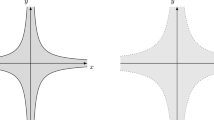Abstract
We study reference-dependent preference relations defined by a real-valued bivariate function and prove an existence criterion for maximal elements. Then we formulate a generalized version of the well-known Brondsted maximum principle and apply it to behavioral traps and Nash equilibrium in games with preference relations that are not necessarily partial orders.
Similar content being viewed by others
References
Koszegi, B., Rabin, M.: A model of reference-dependent preferences. Q. J. Econ. 121(4), 1133–1166 (2006)
Soubeyran, A.: Variational rationality, a theory of individual stability and change: worthwhile and ambidextry behavior. Mimeo (2009)
Brondsted, A.: On a lemma of Bishop and Phelps. Pac. J. Math. 55, 335–341 (1974)
Aleskerov, F., Bouyssou, D., Monjardet, B.: Numerical representations of binary relations with thresholds: a brief survey 1 (2009). www.lamsade.dauphine.fr/dea103/ens/bouyssou/FABM.pdf
Soubeyran, A.: Variational rationality and the unsatisfied man: routines and the course pursuit between aspirations, capabilities and beliefs. Mimeo (2010)
Luc, D.T., Soubeyran, A.: Variable Preferences Relations: Existence of Maximal Elements (2010). Preprint. hal-00621272
Bossert, W., Suzumura, K.: Social norms and rationality of choice. Working paper. Discussion paper series, No. 208. Université de Montreal, COE/RES (2007)
Simon, H.A.: A behavioral model of rational choice. Q. J. Econ. 69, 99–118 (1955)
Simon, H.A.: Models of Man: Social and Rational. Wiley, New York (1957)
Simon, H.A.: From substantive to procedural rationality. In: Latsis (ed.) Methods and Appraisal in Economics (1967)
Simon, H.A.: Rationality as a process and product of thought. Am. Econ. Rev. 68, 1–16 (1978)
Simon, H.A.: The Science of the Artificial, 2nd edn. MIT Press, Cambridge (1982)
Simon, H.A.: Reason in Human Affairs. Stanford University Press, Stanford (1983)
Kahneman, D., Tversky, A.: Prospect theory: an analysis of decision under risk. Econometrica 47(2), 263–292 (1979)
Tversky, A., Kahneman, D.: Loss aversion in riskless choice: a reference dependent model. Q. J. Econ. 106, 1039–1061 (1991)
Flores-Bazán, F., Hernández, E., Novo, V.: Characterizing efficiency without linear structure: a unified approach. J. Glob. Optim. 41, 43–60 (2008)
Lindblom, C.E.: The science of muddling through. PAR, Public Adm. Rev. 19(2), 79–88 (1959)
Greve, W.: Traps and gaps in action explanation: theoretical problems of a psychology of human action. Psychol. Rev. 108(2), 435–451 (2001)
Koszegi, B.: Utility from anticipation and personal equilibrium. Econ. Theory 44, 414–434 (2010)
Gul, F., Pesendorfer, W.: The revealed preference implications of reference dependent preferenes. Mimeo, Princeton University (2006)
Luc, D.T.: On Nash equilibrium. I. Acta Math. Acad. Sci. Hung. 40(3–4), 267–272 (1982)
Luc, D.T.: On Nash equilibrium. II. Acta Math. Hung. 41(1–2), 61–66 (1983)
Attouch, H., Redont, P., Soubeyran, A.: A new class of alternating proximal minimization algorithms with costs-to-move. SIAM J. Optim. 18, 1061–1081 (2007)
Attouch, H., Bolte, J., Redont, P., Soubeyran, A.: Alternating proximal algorithms for weakly coupled convex minimization problems. Applications to dynamical games and PDE’s. J. Convex Anal. 15, 485–506 (2008)
Attouch, H., Soubeyran, A.: Local search proximal algorithms as decision dynamics with costs to move. Set-Valued Var. Anal. 19(1), 157–177 (2010)
Chen, Y., Gazzale, R.: When does learning in games generate convergence to Nash equilibria? The role of supermodularity in an experimental setting. Am. Econ. Rev. 94, 1505–1535 (2004)
Bianchi, M., Kassay, G., Pini, R.: Existence of equilibria via Ekeland’s principle. J. Math. Anal. Appl. 305, 502–512 (2005)
Flores-Bazán, F., Gutierrez, C., Novo, V.: A Brezis–Browder principle on partially ordered spaces and related ordering theorems. J. Math. Anal. Appl. 375, 245–260 (2011)
Acknowledgements
F. Flores-Bazán acknowledges partial support by FONDECYT 110-0667 and BASAL Projects, CMM, Universidad de Chile and Centro de Investigacion en Ingenieria matematica (CI2MA).
This paper was partially written during the stay of the second author at the University of Concepcion under a research grant of CONICYT through a BASAL Project.
Author information
Authors and Affiliations
Corresponding author
Rights and permissions
About this article
Cite this article
Flores-Bazán, F., Luc, D.T. & Soubeyran, A. Maximal Elements Under Reference-Dependent Preferences with Applications to Behavioral Traps and Games. J Optim Theory Appl 155, 883–901 (2012). https://doi.org/10.1007/s10957-012-0100-z
Received:
Accepted:
Published:
Issue Date:
DOI: https://doi.org/10.1007/s10957-012-0100-z



